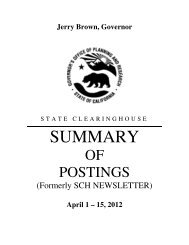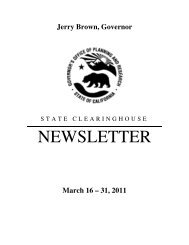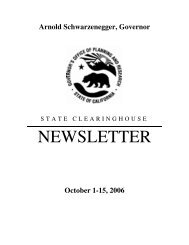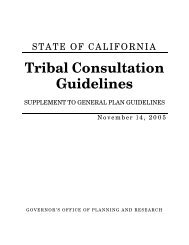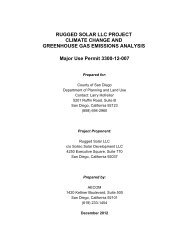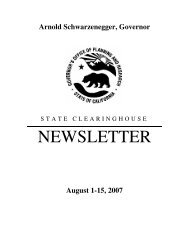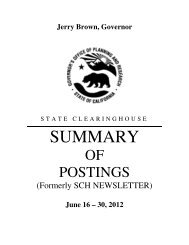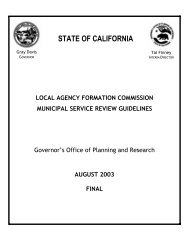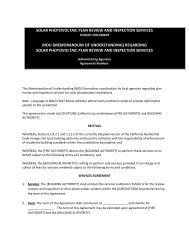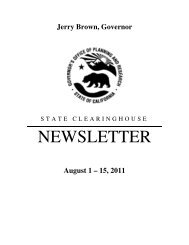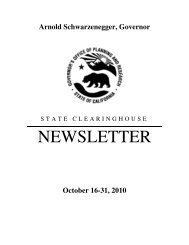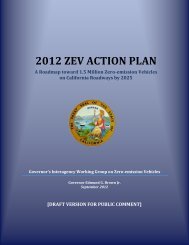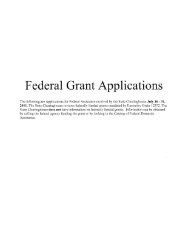Executive Summary - Office of Planning and Research
Executive Summary - Office of Planning and Research
Executive Summary - Office of Planning and Research
Create successful ePaper yourself
Turn your PDF publications into a flip-book with our unique Google optimized e-Paper software.
E X E C U T I V E S U M M A R Y<br />
May 2008
2<br />
What is a Joint L<strong>and</strong> Use Study?<br />
A<br />
Joint L<strong>and</strong> Use Study (JLUS)<br />
is<br />
a collaborative planning effort<br />
bbetween<br />
active military installations,<br />
su surrounding counties <strong>and</strong> cities, <strong>and</strong><br />
oother<br />
aff ected agencies. The JLUS<br />
process is funded by a grant from the Department <strong>of</strong> Defense<br />
Offi ce <strong>of</strong> Economic Adjustment (OEA).<br />
The California JLUS Program<br />
The OEA is funding the preparation <strong>of</strong> two JLUSs in California.<br />
Given the large areas covered by these studies <strong>and</strong> the<br />
number <strong>of</strong> jurisdictions <strong>and</strong> agencies involved, the California<br />
JLUS program is being managed by the Governor’s Offi ce <strong>of</strong><br />
<strong>Planning</strong> <strong>and</strong> <strong>Research</strong> (OPR). The two geographic study areas<br />
included in the California JLUS program are referred to as the<br />
Beale JLUS <strong>and</strong> the R-2508 JLUS.<br />
The Beale JLUS addresses all l<strong>and</strong>s near Beale Air Force Base<br />
(AFB) with a current or potential future impact on military<br />
operations at the base, <strong>and</strong> l<strong>and</strong>s upon which military<br />
operations at the base have an actual or potential impact.<br />
Given the location <strong>of</strong> the base within Yuba County, the study<br />
area includes the western half <strong>of</strong> Yuba County <strong>and</strong> portions<br />
<strong>of</strong> Butte, Nevada, Placer, <strong>and</strong> Sutter counties.<br />
Goals <strong>and</strong> Objecti ves<br />
The overall goal <strong>of</strong> a JLUS is to reduce potential confl icts<br />
while accommodating growth, sustaining the economic<br />
health <strong>of</strong> the region, <strong>and</strong> protecting public health <strong>and</strong> safety.<br />
Like all JLUS programs, the Beale JLUS has three primary<br />
objectives.<br />
Underst<strong>and</strong>ing<br />
Convene community, agency, <strong>and</strong> Beale AFB representatives<br />
to study the issues in an open forum, taking into consideration<br />
both community <strong>and</strong> military viewpoints <strong>and</strong> needs. This<br />
includes public outreach <strong>and</strong> input.<br />
Collaboration<br />
Encourage cooperative l<strong>and</strong> use <strong>and</strong> resource planning<br />
between Beale AFB <strong>and</strong> surrounding communities so that<br />
future community growth <strong>and</strong> development are compatible<br />
with the training <strong>and</strong> operational missions <strong>of</strong> the installation<br />
while at the same time seeking ways to reduce operational<br />
impacts on adjacent l<strong>and</strong>s.<br />
Actions<br />
Provide a set <strong>of</strong> tools, activities, <strong>and</strong> procedures from which<br />
local jurisdictions, agencies, <strong>and</strong> the installation can select<br />
<strong>and</strong> then use to implement the recommendations developed<br />
during the JLUS process. The actions proposed include both<br />
operational measures to mitigate installation impacts <strong>and</strong><br />
local government <strong>and</strong> agency approaches to reduce impacts<br />
on Beale AFB operations.<br />
Beale AFB- Overview<br />
Camp Beale, opened in 1942 as an<br />
Army training facility, originally<br />
occupied 86,000 acres <strong>and</strong> was<br />
home to over 60,000 military<br />
personnel. While Beale today is<br />
smaller in acreage (approximately<br />
23,000 acres) <strong>and</strong> manpower<br />
(approximately 4,200 military<br />
personnel), its strategic importance<br />
to the nation <strong>and</strong> its economic <strong>and</strong><br />
social signifi cance to the local region<br />
remains strong.<br />
Since converting to an Air Force<br />
Base in 1948, Beale AFB has hosted<br />
a range <strong>of</strong> missions, but today it is<br />
known as the center for the United<br />
States' aerial reconnaissance force.<br />
Beale is the home base for all Air<br />
RQ-4 Global Hawk<br />
U-2 Dragon Lady
Force U-2 <strong>and</strong> Global Hawk reconnaissance aircraft. Using<br />
these resources, Beale provides worldwide reconnaissance<br />
data to national <strong>and</strong> theater comm<strong>and</strong>ers. In addition, the<br />
base is one <strong>of</strong> only three sites in the United States supporting<br />
the PAVE (Air Force program name) Phased Array Warning<br />
System (PAWS) long-range radar. This system is vital to the<br />
defense <strong>of</strong> the country, providing an early warning system<br />
for submarine-launched <strong>and</strong> intercontinental ballistic missiles.<br />
The system also detects <strong>and</strong> tracks Earth-orbiting satellites.<br />
BBeale<br />
AFB is located in a rural<br />
se setting, but as development moves<br />
ccloser<br />
to the base, coordinated<br />
eeffort<br />
is needed to ensure that<br />
ggrowth<br />
continues in a manner that<br />
allows Beale to maintain its role in<br />
the nation’s defense, remains a vital member <strong>of</strong> the local<br />
community <strong>and</strong> a major contributor to the local economy.<br />
Beale AFB-Local Importance<br />
Beale is a signifi cant part <strong>of</strong> the regional economy. In 2006,<br />
Beale employed 5,558 persons, which included 4,291 military<br />
personnel <strong>and</strong> 1,267 civilians. Approximately 32 percent <strong>of</strong> the<br />
active duty military personnel stationed at Beale reside on<br />
base, with the remainder living primarily in Yuba <strong>and</strong> Sutter<br />
counties.<br />
Payroll<br />
($249 M)<br />
Expenditures<br />
($140M)<br />
Partnerships<br />
Job Value<br />
Created($62M)<br />
Total Annual Economic Impact,<br />
Beale AFB FY06<br />
The economic impact <strong>of</strong><br />
Beale AFB on the region<br />
is significant. In 2006, the<br />
installation had a payroll <strong>of</strong><br />
$249 million dollars. When<br />
factoring in the creation <strong>of</strong><br />
other jobs, contract award<br />
expenditures, <strong>and</strong> other<br />
purchases in the region, the<br />
installation estimates it had<br />
a total economic impact <strong>of</strong><br />
$451 million.<br />
The Beale JLUS builds upon existing partnerships by bringing<br />
together local communities, state agencies, federal agencies<br />
<strong>and</strong> Beale AFB in decision-making processes regarding military<br />
operations <strong>and</strong> l<strong>and</strong> use. It will help reduce potential confl icts<br />
<strong>and</strong> sustain the military mission, but this is also balanced with<br />
the need to accommodate growth, promote the economic<br />
health <strong>of</strong> the region <strong>and</strong> protect public health <strong>and</strong> safety.<br />
Beale <strong>and</strong> the local communities are also linked through the<br />
services each provides. With many military personnel <strong>and</strong><br />
their families living in nearby communities, local jurisdictions<br />
<strong>and</strong> agencies provide a range <strong>of</strong> services to these personnel,<br />
from public schools <strong>and</strong> libraries to police <strong>and</strong> fi re protection.<br />
Beale AFB also gives back to local communities through the<br />
involvement <strong>of</strong> base personnel in local charities <strong>and</strong> other<br />
civic organizations <strong>and</strong> by responding with critical services<br />
when needed, such as fi re response, explosive ordnance<br />
disposal, <strong>and</strong> emergency services to support fl ood response<br />
<strong>and</strong> relief.<br />
A Growing Region<br />
As growth continues to exp<strong>and</strong> out <strong>of</strong> the Sacramento<br />
metropolitan area, the fi ve counties that make up the region<br />
surrounding Beale AFB (Butte, Nevada, Placer, Sutter, <strong>and</strong><br />
Yuba counties) are projected to<br />
have strong residential, commercial,<br />
<strong>and</strong> industrial growth over the next<br />
several decades. By the year 2050,<br />
these fi ve counties are projected to<br />
increase in population from about<br />
795,000 persons in 2006 to almost<br />
1.4 million persons by the year 2050.<br />
This 73 percent growth will add<br />
over 600,000 new residents to the<br />
area, <strong>and</strong> transform several small<br />
rural communities into mid-sized Downtown Marysville<br />
communities.<br />
Beale JLUS<br />
The goal <strong>of</strong> the Beale JLUS is to protect the viability <strong>of</strong><br />
current <strong>and</strong> future missions at Beale while at the same time<br />
accommodating growth, sustaining the economic health <strong>of</strong><br />
the region, <strong>and</strong> protecting public health <strong>and</strong> safety.<br />
The Beale JLUS is designed to address l<strong>and</strong>s near Beale AFB<br />
that meet the following criteria:<br />
• L<strong>and</strong> areas that have resources, activities, or l<strong>and</strong> uses<br />
(existing or future) that may impact current or future<br />
military operations.<br />
• L<strong>and</strong> areas upon which military operations associated with<br />
the base may have an impact on resources, activities, or<br />
l<strong>and</strong> uses (existing or future).<br />
The 15-mile oval study area, measured from the centerline<br />
<strong>of</strong> the Beale AFB runway, includes the western half <strong>of</strong> Yuba<br />
County <strong>and</strong> portions <strong>of</strong> Butte, Nevada, Placer, <strong>and</strong> Sutter<br />
counties.<br />
3
4<br />
Beale JLUS Overview<br />
The Beale JLUS is not an adopted plan. It is a strategy guide that<br />
will be used by local jurisdictions, agencies, <strong>and</strong> organizations<br />
in the study area to guide their future compatibility eff orts. It is<br />
through the future actions <strong>of</strong> the stakeholders involved that the<br />
JLUS strategies will become a reality. For example:<br />
• Local jurisdictions will use the strategies in this JLUS to guide<br />
future general plan <strong>and</strong> zoning updates, as well as assist in<br />
the review <strong>of</strong> development proposals.<br />
• Beale AFB will use the JLUS to guide their interactions with<br />
the community on future projects.<br />
1. Introduction<br />
Section 1 provides an introduction <strong>and</strong> context for the Beale<br />
JLUS. This section describes the goals <strong>and</strong> objectives used to<br />
guide development <strong>of</strong> the JLUS, who was involved in making the<br />
JLUS a success, public outreach methods, <strong>and</strong> the organization<br />
<strong>of</strong> the document.<br />
2. Study Area Pr<strong>of</strong>i le<br />
In developing a JLUS, a good underst<strong>and</strong>ing <strong>of</strong> the installation<br />
<strong>and</strong> local jurisdictions within the study area is necessary. For the<br />
Beale JLUS, this section provides: an overview <strong>of</strong> the installation’s<br />
history, a description <strong>of</strong> the primary activity areas on the base, a<br />
look at the current mission <strong>and</strong> military units located at the base,<br />
military family housing assets, the economic impact <strong>of</strong> the base<br />
on the region, <strong>and</strong> a discussion <strong>of</strong> future missions. This is followed<br />
by an overview <strong>of</strong> the region’s growth potential <strong>and</strong> a pr<strong>of</strong>i le <strong>of</strong><br />
each <strong>of</strong> the counties <strong>and</strong> cities within the study area, including<br />
population, housing, <strong>and</strong> employment statistics.<br />
3. Compatibility Issues<br />
Compatibility, in relationship to military readiness, can be<br />
defi ned as the balance or compromise between community<br />
needs <strong>and</strong> interests <strong>and</strong> military needs <strong>and</strong> interests. The goal<br />
<strong>of</strong> compatibility planning is to promote an environment where<br />
both entities can coexist successfully.<br />
In order to develop potential solutions, it is critical to underst<strong>and</strong><br />
the nature <strong>of</strong> existing <strong>and</strong> potential compatibility issues. A<br />
number <strong>of</strong> factors infl uence whether community <strong>and</strong> military<br />
plans, programs, <strong>and</strong> activities are compatible or in confl ict. In this<br />
section, the JLUS presents a list <strong>of</strong> 24 compatibility factors that<br />
were used to characterize local issues. In addition to describing<br />
existing <strong>and</strong> potential compatibility issues currently identifi ed,<br />
this list can be used in the future to assist in reviewing plans,<br />
programs, or development proposals <strong>and</strong> related applications.<br />
4. Existing Plans <strong>and</strong> Programs<br />
This section provides an overview <strong>of</strong> relevant plans, programs,<br />
<strong>and</strong> studies currently used to address compatibility issues in the<br />
study area. This includes technical studies, such as the current<br />
Beale Air Installation Compatibility Use Zone (AICUZ), as well as<br />
local general plans <strong>and</strong> zoning ordinances.<br />
5. Recommendations<br />
The fi nal section <strong>of</strong> the JLUS is a toolbox comprised <strong>of</strong> strategies<br />
that have been developed cooperatively with representatives<br />
from local jurisdictions, Beale AFB, state <strong>and</strong> federal agencies,<br />
Native American tribal governments, local organizations,<br />
<strong>and</strong> interested individuals <strong>and</strong> l<strong>and</strong>owners. The result <strong>of</strong> a<br />
collaborative planning process, the recommendations in this<br />
section represent a true consensus plan: a realistic, coordinated<br />
approach to compatibility planning developed with the support<br />
<strong>of</strong> the stakeholders involved.<br />
6. Acronyms<br />
A listing, with defi nitions, <strong>of</strong> the acronyms used in the JLUS.<br />
Recommended Strategies<br />
The heart <strong>of</strong> the Beale JLUS is the set <strong>of</strong> recommended strategies<br />
contained in Section 5. The strategies in this section address<br />
the range <strong>of</strong> compatibility issues noted in Section 3. For ease<br />
<strong>of</strong> reference, the strategies are grouped into 21 strategy types.<br />
These are described below.<br />
Military Infl uence Areas (MIA)<br />
A MIA is a formally designated geographic planning area<br />
where military operations may impact local communities, <strong>and</strong><br />
conversely, where local activities may aff ect the military’s ability<br />
to carry out its mission. The MIAs proposed are shown on the<br />
diagram on the facing page.<br />
Acquisitions<br />
As a l<strong>and</strong> use planning tool, property rights can be acquired<br />
through donation, easement, or the outright purchase <strong>of</strong><br />
property for public purposes.<br />
AICUZ<br />
The AICUZ program, a Department <strong>of</strong> Defense (DOD) planning<br />
program that was developed in response to incompatible urban<br />
development <strong>and</strong> l<strong>and</strong> use confl icts around military airfi elds, has<br />
two objectives:<br />
• To assist local, regional, state, <strong>and</strong> federal <strong>of</strong>ficials in<br />
protecting the public health, safety, <strong>and</strong> welfare by<br />
promoting compatible development within the AICUZ area<br />
<strong>of</strong> infl uence.<br />
• To protect operational capabilities from the eff ects <strong>of</strong> l<strong>and</strong><br />
uses that are incompatible with aircraft operations.
Airport L<strong>and</strong> d Use Compatibility b l<br />
An Airport L<strong>and</strong> Use Compatibility Plan (ALUCP) is a plan, usually<br />
adopted by a County Airport L<strong>and</strong> Use Commission (ALUC) or<br />
other entity established to accomplish l<strong>and</strong> use compatibility<br />
planning, which sets forth policies for promoting compatibility<br />
between airports <strong>and</strong> the l<strong>and</strong> uses which surround them.<br />
Avigation Easements<br />
An easement is a non-possessory right to use l<strong>and</strong> owned by<br />
another party. An avigation easement is an easement that grants<br />
the holder one or more <strong>of</strong> the following rights:<br />
• The right <strong>of</strong> fl ight;<br />
• The right to cause noise, dust, or other impacts related<br />
to aircraft fl ight;<br />
• The right to restrict or prohibit certain lights,<br />
electromagnetic signals, <strong>and</strong> bird-attracting l<strong>and</strong> uses;<br />
• The right to unobstructed airspace over the property<br />
above a specifi ed height.<br />
BASH Coordination<br />
The Bird / Wildlife Strike Hazard<br />
(BASH) program is aimed at<br />
minimizing collisions between<br />
military aircraft <strong>and</strong> birds or other<br />
animals, <strong>and</strong> to minimize damage<br />
Birds gathering near airfi eld<br />
5
6<br />
Strategy Type<br />
MIAs<br />
Acquisiti ons<br />
AICUZ<br />
ALUCP<br />
Avigati on<br />
BASH<br />
Beale <strong>Planning</strong><br />
Codes<br />
CIP<br />
CEQA / NEPA<br />
# Strategy MIA I<br />
1 Defi ne <strong>and</strong> Establish MIA Zones<br />
Geographic<br />
Area<br />
Time-<br />
frame<br />
MIA IIA<br />
MIA IIB<br />
MIA III<br />
0-2 Years<br />
3-5 Years<br />
Ongoing<br />
✓✓✓✓✓ ✓<br />
2 Identi fy Priority Locati ons for Acquisiti on ✓✓ ✓ ✓<br />
3 Establish Voluntary Acquisiti on Program ✓✓ ✓<br />
4 Establish Conservati on Easement Program ✓✓✓ ✓<br />
5 Develop Transfer <strong>of</strong> Development Rights<br />
Program ✓✓ ✓ ✓<br />
6 Use L<strong>and</strong> <strong>and</strong> Water Conservati on Fund<br />
Grants ✓✓✓ ✓<br />
7 Use DOD Easement Partnership Program ✓✓<br />
8 Focus Conservati on Partnering Opportuniti es ✓✓<br />
9 Implement AICUZ Recommendati ons<br />
✓<br />
✓<br />
✓✓ ✓ ✓<br />
10 Update ALUCP to Refl ect Current AICUZ ✓ ✓ ✓<br />
11 Update ALUCP <strong>and</strong> Associated Ordinances ✓ ✓ ✓<br />
12 Involve Beale AFB Offi cials in Airport<br />
<strong>Planning</strong><br />
13 Develop or Update Avigati on Easement<br />
Programs<br />
✓✓✓✓ ✓<br />
✓ ✓<br />
14 Develop <strong>and</strong> Distribute BASH Educati onal<br />
Materials ✓✓✓✓✓ ✓<br />
15 Control Bird <strong>and</strong> Wildlife Att racti ons Near<br />
Base ✓✓✓ ✓<br />
16 Flight Operati ons for Future Missions ✓✓✓✓ ✓<br />
17 Update Beale AFB General Plan ✓✓✓✓ ✓<br />
18 Develop Public <strong>Summary</strong> <strong>of</strong> Beale AFB General<br />
Plan ✓✓✓✓ ✓✓<br />
19 Involve Local Jurisdicti ons in Defi ning Data<br />
Needs ✓✓✓✓ ✓✓<br />
20 Require Appropriate Sound Att enuati on for<br />
Occupied Buildings ✓✓ ✓<br />
21 Require Appropriate Sound Att enuati on for<br />
Schools ✓✓ ✓<br />
22 Incorporate Compati bility <strong>Planning</strong> Concepts<br />
in CIPs ✓✓✓ ✓<br />
23 Ensure Adequate Transportati on<br />
Infrastructure ✓✓✓✓ ✓✓<br />
24 Incorporate Beale Into Regional<br />
Infrastructure <strong>Planning</strong> ✓✓✓✓ ✓<br />
25 Refer CEQA Documents to Beale AFB ✓✓✓✓ ✓<br />
26 Refer NEPA Documents to Local Jurisdicti ons ✓✓✓✓ ✓<br />
<strong>and</strong> injuries when collisions occur. The program<br />
considers not only wildlife within the confi nes <strong>of</strong> the<br />
airfi eld, but also in neighboring areas.<br />
Beale <strong>Planning</strong> <strong>and</strong> Operations<br />
Similar to a local jurisdiction, Beale AFB maintains a<br />
long-range general plan. The purpose <strong>of</strong> the Beale<br />
AFB General Plan is to provide an assessment <strong>of</strong> the<br />
installation’s infrastructure <strong>and</strong> attributes for the<br />
purpose <strong>of</strong> gauging the installation’s development <strong>and</strong><br />
growth potential.<br />
Building Codes<br />
Construction st<strong>and</strong>ards <strong>and</strong> building codes are<br />
ordinances <strong>and</strong> regulations controlling the design,<br />
construction process, materials, alteration, <strong>and</strong><br />
occupancy <strong>of</strong> any structure to safeguard human safety<br />
<strong>and</strong> welfare. They include both technical <strong>and</strong> functional<br />
st<strong>and</strong>ards <strong>and</strong> generally address the following:<br />
•<br />
•<br />
•<br />
•<br />
Structural Safety<br />
Fire Safety<br />
Health Requirements<br />
Accessibility<br />
Capital Improvement Programs (CIP)<br />
A CIP is a detailed fi scal <strong>and</strong> planning document used<br />
to plan <strong>and</strong> direct a jurisdiction’s or agency’s (federal or<br />
state) investment in facilities, including infrastructure.<br />
The CIP lays out the facility plans <strong>and</strong> programs <strong>of</strong><br />
the jurisdiction or agency <strong>and</strong> provides details on<br />
expenditures that can be incorporated into the<br />
jurisdiction’s or agency’s annual budgeting process.<br />
CEQA / NEPA<br />
The California Environmental Quality Act (CEQA)<br />
was enacted in 1970 <strong>and</strong> requires all lead agencies to<br />
consider the potential environmental impacts <strong>of</strong> a<br />
project before they approve it.<br />
The National Environmental Policy Act (NEPA) is the<br />
federal law, eff ective on January 1, 1970, that established<br />
a national policy for the environment <strong>and</strong> requires<br />
federal agencies:<br />
• To become aware <strong>of</strong> the environmental<br />
ramifi cations <strong>of</strong> their proposed actions,<br />
• To fully disclose to the public proposed federal<br />
actions <strong>and</strong> provide a mechanism for public input<br />
to federal decision making, <strong>and</strong><br />
• To prepare environmental impact statements for<br />
every major action that would signifi cantly aff ect<br />
the quality <strong>of</strong> the human environment.
Code Enforcement / Building Inspection<br />
The purpose <strong>of</strong> code enforcement programs is to<br />
promote <strong>and</strong> maintain a safe <strong>and</strong> desirable living <strong>and</strong><br />
working environment. Related to l<strong>and</strong> use compatibility,<br />
code enforcement is a tool used by the community to<br />
ensure its rules are enforced.<br />
Communication / Coordination<br />
In any planning eff ort, plans can only move towards<br />
successful implementation if there are ongoing<br />
communications between Beale AFB, local jurisdictions,<br />
Native American tribal governments, agencies,<br />
l<strong>and</strong>owners, <strong>and</strong> the public. Enhanced communication<br />
<strong>and</strong> coordination is integral to successful compatibility<br />
planning in the study area.<br />
Deed Restrictions / Covenants<br />
Deed restrictions, or covenants, are written agreements<br />
that restrict or limit some <strong>of</strong> the rights associated with<br />
property ownership. These restrictions are recorded<br />
with the deed for the property <strong>and</strong> stay with the<br />
property when it is sold to a new owner (i.e., remain<br />
in eff ect).<br />
General Plans (Counties / Cities)<br />
Every city <strong>and</strong> county in California is required by state<br />
law to prepare <strong>and</strong> maintain a policy document called a<br />
general plan. General plans are designed to serve as the<br />
jurisdiction’s blueprint for future decisions concerning<br />
physical development, including l<strong>and</strong> use, infrastructure,<br />
public services, <strong>and</strong> resource conservation. All specifi c<br />
plans, subdivisions, public works projects, <strong>and</strong> zoning<br />
decisions made by the local government must be<br />
consistent with the general plan.<br />
Habitat Conservation Tools<br />
The California Natural Community Conservation<br />
<strong>Planning</strong> Act <strong>and</strong> the Federal Endangered Species<br />
Act allow for the development <strong>of</strong> Natural Community<br />
Conservation Plans (NCCPs) <strong>and</strong> Habitat Conservation<br />
Plans (HCPs). An NCCP identifi es <strong>and</strong> provides for the<br />
regional or areawide protection <strong>of</strong> plants, animals,<br />
<strong>and</strong> their habitats, while allowing compatible <strong>and</strong><br />
appropriate economic activity.<br />
Hazard Mitigation Plans<br />
Hazard mitigation is defi ned as any sustained, costeff<br />
ective action taken to reduce or eliminate long-term<br />
risk to people, property, <strong>and</strong> the environment from<br />
natural <strong>and</strong> man-made hazards <strong>and</strong> their eff ects.<br />
Strategy Type<br />
Code<br />
Communicati ons/ Coordinati on<br />
Deed Res.<br />
General Plans<br />
Habitat Conservati on<br />
Hazard Mit.<br />
# Strategy MIA I<br />
Geographic<br />
Area<br />
Time-<br />
frame<br />
MIA IIA<br />
MIA IIB<br />
MIA III<br />
0-2 Years<br />
3-5 Years<br />
27 Ensure Constructi on St<strong>and</strong>ards for Noise are<br />
Met ✓✓ ✓<br />
28 Code Enforcement Relati ve to Compati bility<br />
Concerns<br />
29 Establish a JLUS Coordinati ng Committ ee<br />
✓✓✓✓ ✓<br />
Ongoing<br />
✓✓✓✓✓ ✓<br />
30 Establish Procedures for Plan Review <strong>and</strong><br />
Comment<br />
✓✓✓✓✓<br />
31 Refer Development Applicati ons to Beale for<br />
Review /Comment ✓✓✓✓ ✓<br />
32 Refer Local Proposals to Beale for Review <strong>and</strong><br />
Comment<br />
33 Coordinati on on School Site <strong>Planning</strong><br />
✓✓ ✓<br />
✓✓ ✓ ✓<br />
34 Educati onal Outreach on Aviati on <strong>Planning</strong> ✓✓✓✓ ✓<br />
35 Develop <strong>and</strong> Distribute Public Educati on<br />
Materials ✓✓✓✓✓ ✓<br />
36 Beale Public Aff airs Liaison to JLUS<br />
Coordinati ng Committ ee ✓✓✓✓✓ ✓<br />
37 Technical Support for Local Decision Making<br />
Process ✓✓✓ ✓<br />
38 Acti vely Seek Local Input on Compati bility<br />
Issues ✓✓✓✓ ✓<br />
39 Establish <strong>and</strong> Maintain Compati bility<br />
Clearinghouse<br />
40 Recommend Deed Restricti ons in Impacted<br />
Areas<br />
✓✓✓ ✓ ✓<br />
41 Updati ng Local General Plans<br />
✓✓ ✓<br />
✓✓✓✓✓✓✓<br />
42 Incorporati ng Military Housing Needs in<br />
Local Housing Elements ✓✓✓✓ ✓✓<br />
43 Support Completi on <strong>of</strong> Yuba-Sutt er NCCP /<br />
HCP<br />
44 Update Plans to Refl ect Current <strong>and</strong> Former<br />
Military Operati ons<br />
✓✓✓✓ ✓<br />
✓✓✓✓ ✓✓<br />
7
8<br />
Strategy Type<br />
MOU<br />
Real Estate<br />
Zoning /Subdivision<br />
Other<br />
Strategy Type<br />
AOC<br />
# Strategy MIA I<br />
Geographic<br />
Area<br />
Time-<br />
frame<br />
MIA IIA<br />
MIA IIB<br />
MIA III<br />
0-2 Years<br />
3-5 Years<br />
45 Develop General MOU to Implement JLUS<br />
Process ✓✓✓ ✓<br />
46 Develop Specifi c MOUs to Implement JLUS<br />
Recommendati ons<br />
47 Develop an Enhanced Real Estate Disclosure<br />
Ordinance<br />
✓✓✓ ✓<br />
48 Encourage Area <strong>Planning</strong> Approach<br />
Ongoing<br />
✓✓✓ ✓ ✓<br />
✓✓✓ ✓<br />
49 Incorporate AICUZ Compati bility Guidelines,<br />
Part 1 ✓✓✓ ✓<br />
50 Incorporate AICUZ Compati bility Guidelines,<br />
Part 2 ✓✓<br />
51 Ensure FAA Part 77 Compliance<br />
✓<br />
✓✓✓✓ ✓<br />
52 Develop or Update Light <strong>and</strong> Glare Controls ✓✓✓✓✓<br />
53 Modify Subdivision Regulati ons, Disclosure ✓✓✓ ✓<br />
54 Reduce Bird <strong>and</strong> Wildlife Att racti on Near<br />
Base ✓✓✓✓ ✓<br />
55 Pursue Additi onal Missions at Beale AFB<br />
✓✓✓✓ ✓<br />
56 Encourage <strong>Research</strong> on Noise Att enuati on ✓✓✓✓ ✓<br />
# Strategy AOC 1<br />
57 Defi ne <strong>and</strong> Establish JLUS Areas <strong>of</strong> Concern<br />
58 Enhanced Disclosure Requirements in AOC<br />
AOC 2<br />
0-2 Years<br />
3-5 Years<br />
Ongoing<br />
✓✓ ✓ ✓<br />
✓✓ ✓ ✓<br />
59 Investi gate Development <strong>of</strong> Electrical /<br />
Electromagneti c Interference Ordinance ✓ ✓<br />
Memor<strong>and</strong>um Mem <strong>of</strong> Underst<strong>and</strong>ing<br />
A Memor<strong>and</strong>um M<br />
<strong>of</strong> Underst<strong>and</strong>ing (MOU) is a<br />
contract cont between two or more government entities.<br />
The governing bodies <strong>of</strong> the participating public<br />
agencies agen must take appropriate legal actions, <strong>of</strong>ten<br />
adoption ado <strong>of</strong> an ordinance or resolution before such<br />
agreements agre become eff ective. These agreements<br />
are also known as Joint Powers Agreements or<br />
Interlocal Inte Agreements.<br />
Real Rea Estate Disclosure<br />
Prior Prio to the transfer <strong>of</strong> real property to a new<br />
owner, own California law requires sellers <strong>and</strong> their<br />
agents age to disclose all actual known facts related<br />
to tthe<br />
condition <strong>of</strong> the property. This disclosure<br />
should sho include noise or other proximity impacts<br />
associated asso with property located near a military<br />
installation inst or operations area.<br />
Zoning Zon / Subdivision / Other Local<br />
Regulations<br />
Reg<br />
Zoning Zon - Zoning is the division <strong>of</strong> a jurisdiction into<br />
districts dist (zones) within which permissible uses are<br />
prescribed pres <strong>and</strong> restrictions on building height, bulk,<br />
layout layo <strong>and</strong> other requirements are defi ned.<br />
Subdivisions Sub - L<strong>and</strong> cannot be divided in California<br />
without with local government approval. Dividing l<strong>and</strong><br />
for sale, lease or fi nancing is regulated by local<br />
ordinances ord based on the State Subdivision Map<br />
Act. Act Subdivision ordinances set forth the minimum<br />
requirements req<br />
deemed necessary to protect the<br />
health, hea safety, <strong>and</strong> welfare <strong>of</strong> the public.<br />
Other Oth Strategies<br />
These The are strategies that did not fi t specifi cally<br />
und under one <strong>of</strong> the previous tool categories.<br />
JLUS JLU Areas <strong>of</strong> Concern (AOC)– Strategies<br />
These The strategies apply to the JLUS Areas <strong>of</strong> Concern<br />
- AOC1 AO (Firing Range 10,000 foot radius) <strong>and</strong> the<br />
JLUS JLU AOC2 (PAVE PAWS 3-mile radius). See the<br />
diagram diag on page 5 for locations.<br />
For More Informati on<br />
The complete JLUS document can be downloaded<br />
from the OPR website at: www.opr.ca.gov



